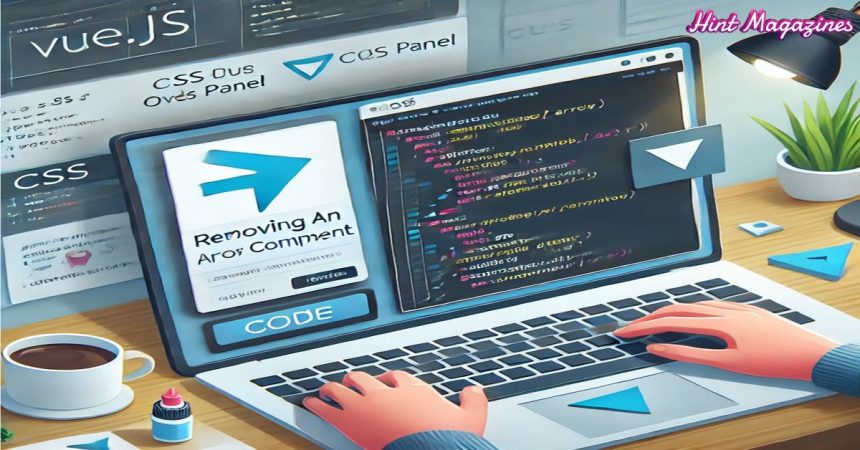Introduction: Remove Arrow in OverlayPanel Prime Vue
PrimeVue is a Vue. J’s UI component library with vast components that help you build modern web apps. The OverlayPanel component is a standard piece of code that provides a popping panel to present extra content. Although OverlayPanel’s default configuration has an arrow pointing toward the trigger element, it might only sometimes fit your design tastes.
This blog post will show us how to Remove Arrow in OverlayPanel Prime Vue and customize it to our needs. We’ll also respond to frequently asked questions that will help you become an absolute master of the process.
Using OverlayPanel in PrimeVue
Before we remove the arrow, let’s quickly remind ourselves what an Overlay Panel does and how it works. An Overlay Panel is a container in PrimeVue that can be shown or hidden, just like a tooltip or dropdown menu. We often use it to show additional content, e.g., a menu, a form, or extra info when a user does some action, such as clicking on a button.
The default OverlayPanel has an arrow indicating the relationship between the trigger element and the content. While the arrow can be helpful in some scenarios, you might want to remove it to maintain a minimalistic design or to customize the appearance according to your UI requirements.
Why Remove the Arrow in OverlayPanel?
There are several reasons why developers might want to remove the arrow from the OverlayPanel:
- Consistency in Design: If your application uses pop-ups or tooltips without arrows in other interface parts, you might want the OverlayPanel to follow the same design pattern for consistency.
- Better Aesthetics: The arrow may not always match your design theme. Removing it can help achieve a cleaner look.
- Custom Positioning: Sometimes, developers may prefer to position the OverlayPanel more freely without considering where the arrow points.
Regardless of the reason, removing the arrow is straightforward, with a few tweaks.
Step-by-Step Guide to Removing the Arrow in OverlayPanel PrimeVue
Here is a step-by-step guide on how to remove the arrow from the OverlayPanel in PrimeVue:
Step 1: Install and Set Up PrimeVue
Before making any changes, ensure you have PrimeVue installed and configured correctly in your Vue.js project. If you haven’t already done this, you can install PrimeVue using npm:
bash
Copy code
npm install primevue –save
Also, install the required PrimeVue styles and dependencies:
bash
Copy code
npm install primeicons primeflex –save
Next, configure PrimeVue in your main application file, typically main.js or main.ts:
javascript
Copy code
import { createApp } from ‘vue’;
import PrimeVue from ‘primevue/config’;
import ‘primevue/resources/themes/saga-blue/theme.css’; // Choose your theme
import ‘primevue/resources/primevue.min.css’;
import ‘primeicons/primeicons.css’;
const app = createApp(App);
app.use(PrimeVue);
app.mount(‘#app’);
Step 2: Create the OverlayPanel Component
Now, create an OverlayPanel component with a button to trigger it. Here’s a basic example:
Vue
Copy code
<template>
<div>
<Button label=”Show” @click=”togglePanel” />
<OverlayPanel ref=”op” :dismissable=”true”>
<p>This is the content inside the OverlayPanel.</p>
</OverlayPanel>
</div>
</template>
<script>
import { ref } from ‘vue’;
import { Button } from ‘primevue/button’;
import { OverlayPanel } from ‘primevue/overlay panel’;
export default {
components: {
Button,
OverlayPanel
},
setup() {
const op = ref(null);
const togglePanel = () => {
op.value.toggle(event);
};
return {
op,
togglePanel
};
}
};
</script>
<style scoped>
/* Add any component-specific styles here */
</style>
At this point, you will see an arrow pointing towards the button when the OverlayPanel is displayed. Let’s move on to removing the arrow.
Step 3: Use CSS to Remove the Arrow
PrimeVue’s OverlayPanel arrow is styled using CSS. To remove the arrow, you need to override the default styles. Here’s how you can do it:
CSS
Copy code
/* Custom CSS to hide the arrow in OverlayPanel */
.p-overlay panel: before {
display: none;
}
Add this CSS code to your global stylesheet (e.g., styles.css) or directly in your component’s <style> block with a scoped attribute. This will hide the arrow by setting its display property to none.
Step 4: Further Customizing the OverlayPanel
Now that the arrow is removed, you may want to adjust other aspects of the OverlayPanel for better aesthetics or functionality. Here are some common customizations:
- Adjusting the Position: You can change the position of the OverlayPanel relative to the triggering element using custom CSS or JavaScript.
- Custom Animation: You can modify the default show/hide animation using PrimeVue’s animation properties or add custom animation styles.
- Styling the Content: Customize the content inside the OverlayPanel by applying your styles, such as padding, border-radius, or background colour.
Step 5: Testing the Changes
Once you’ve made these changes, test the functionality in your local development environment to ensure the arrow is removed and the OverlayPanel behaves as expected. You can also use different screen sizes to check if the changes are responsive.
Code Example: A Fully Customized OverlayPanel
Here’s an example combining all the steps above with additional customizations for better aesthetics:
Vue
Copy code
<template>
<div>
<Button label=”Show Panel” @click=”togglePanel” />
<OverlayPanel ref=”op” :dismissable=”true” styleClass=”custom-overlay”>
<p>This is a customized OverlayPanel without an arrow.</p>
</OverlayPanel>
</div>
</template>
<script>
import { ref } from ‘vue’;
import { Button } from ‘primevue/button’;
import { OverlayPanel } from ‘primevue/overlay panel’;
export default {
components: {
Button,
OverlayPanel
},
setup() {
const op = ref(null);
const togglePanel = (event) => {
op.value.toggle(event);
};
return {
op,
togglePanel
};
}
};
</script>
<style scoped>
.custom-overlay .p-overlay panel: before {
display: none;
}
.custom-overlay {
border-radius: 8px;
padding: 16px;
background-color: #f9f9f9;
box-shadow: 0 4px 8px rgba(0, 0, 0, 0.2);
}
</style>
In this example, we added a custom class to the OverlayPanel to further style it after hiding the arrow.
Frequently Asked Questions About Remove Arrow in OverlayPanel Prime Vue
Here are some common questions related to removing the arrow in OverlayPanel for PrimeVue:
- How Do I Remove the Arrow from the OverlayPanel in PrimeVue?
To remove the arrow, add the following CSS code to your stylesheet:
CSS
Copy code
.p-overlay panel: before {
display: none;
}
This CSS rule hides the arrow by setting its display property to none.
- Can I Customize the OverlayPanel in PrimeVue Without the Arrow?
Yes, you can customize the OverlayPanel to suit your design needs. After removing the arrow, you can apply additional CSS to style the panel’s background, borders, animations, and other aspects.
- What CSS Changes Are Needed to Hide the Arrow in the PrimeVue OverlayPanel?
To hide the arrow, you must override the default CSS for the OverlayPanel by setting .p-overlay panel: before { display: none; }. You can then add further customizations if desired.
- Is It Possible to Disable the Arrow in the PrimeVue OverlayPanel by Default?
PrimeVue does not provide a built-in option to turn off the arrow. However, as the examples above demonstrate, you can easily remove it with a simple CSS override.
- How Can I Modify the Appearance of the OverlayPanel in PrimeVue?
You can modify the appearance by adding custom styles to the OverlayPanel. For instance, you can adjust the padding, background colour, border radius, and other properties to match your application’s design.
Best Practices for Customizing PrimeVue Components
When customizing PrimeVue components, consider the following best practices:
- Avoid Directly Modifying Library Files: Use CSS overrides and component props to customize the components rather than changing the source library files.
- Test Across Different Devices: Make sure your customizations are responsive and perform well on various screen sizes.
- Keep Your Styles Organized: Use separate style classes or scoped styles in your Vue components for better maintainability.
Conclusion: Remove Arrow in OverlayPanel Prime Vue
Removing the arrow from the OverlayPanel in PrimeVue is straightforward and involves a simple CSS override. Following the steps in this guide, you can customize the OverlayPanel to fit your design needs, ensuring consistency across your application’s UI.
With the examples and FAQs, you now understand how to remove the arrow and style the OverlayPanel as desired. Remember to follow best practices for customizing PrimeVue components to maintain a clean and scalable codebase.





